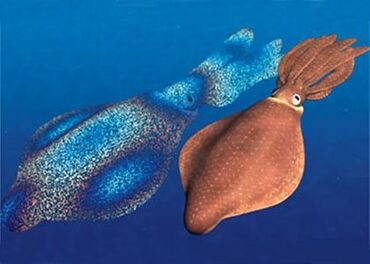
A giant rainbow squid descends into the unfathomable depths of the Global Ocean, eating a freshly caught ocean flish.
The rainbow squid is an enormous, rorqual whale-sized squid, from the Global Ocean, 200 million AD, in The Future is Wild.
Sometimes, several flocks of ocean flish will gather above one whirling silverswimmer shoal. Suddenly, a rainbow squid tentacle will snap from the water surface, seizing a flish and disappears. The shoal then vanishes as well, and in its place appears a broad, dark shape - the back of the enormous animal drifting just below the surface.
Part of the shoal is not a shoal at all, but the changing pattern on the skin of this beast. With a body 65½ feet (20 meters) long, and tentacles of similar length, this is the biggest animal in the Global Ocean.
Like other cephalopods, the rainbow squid has the ability to change color at will. It can merge with the ubiquitous green of the ocean and hide from sight; or flash up a sudden dramatic display to scare away would be predators or to attract a mate. It can even produce a flowing pattern of colored patches to mimic the swirling motion of a shoal of silverswimmers--bait for the ocean flish on which it feeds.
The rainbow squid has shaken off the evolutionary manacles of its ancestors to achieve this feat. While the lifespan of a typical squid of previous times was only two years, other, simpler mollusks could live for decades. Once the squid had escaped this live-fast-die-young cycle, it was able to unlock its evolutionary potential. In the Global Ocean, the rainbow squid has virtually no predators (few other creatures would dare to take on such a giant) and can now live for up to a century. With this extended lifespan has come a highly-evolved intelligence and sophistication.
The sophistication of the rainbow squid is evident in the way it controls changes of color, through pigmented muscular sacs on the surface of its skin called chromatophores. These can be expanded or contracted at will, producing color changes or flowing patterns over the surface of the whole animal. Each chromatophore is controlled by its nerve, part of a complex nervous system connected to the brain.
The rainbow squid's large brain enables it to command the flashes, pulses and rippling patterns that make up the display across its back. Its senses are acute. Indeed, it is so sensitive to its surrounding environment that it is able to choose the appropriate display for any situation: attraction, warming or bait for prey. These color pigments are present in each chromatophore, and combinations of these can produce an almost infinite variety of patterns. Some even contain symbiotic, luminous bacteria, enabling the squid to produce displays of light.
Once a year, this skill is put to dazzling use. On the night of the full moon on the autumnal equinox, the entire population of rainbow squids gathers to mate. Normally rainbow squids are solitary creatures, ranging all across the Global Ocean, but at this one time of year they all converge on a particular area off the southwestern cape of Novopangea, setting the sea ablaze with their vivid displays of color and light. They do this near seamounts.

The autumnal equinox marks the start of the mating season for rainbow squid. Males set the sea ablaze with their vivid displays of color and light.
Females choose males according to their display - the better the display, the more successful the individual is likely to be in hunting, and the more likely to produce equally successful offspring.
Further evidence of the advanced intelligence of rainbow squids can be found in their family relationships. The squids recognize relatives through family-specific chromatophore displays which they produce by sending unique messages from the brain. Each individual has the ability to learn this social behavior and communicate with other members of the group.
Huge as they are, rainbow squids still have a few enemies, chief among them is the sharkopath. The rainbow squid's camouflage is so effective that it melts into the background as soon as it notices the danger. By spreading a light color across its underbelly, crisscrossed with rippling patterns like surface waves, it disguises itself from attackers coming from below. By darkening its back to merge with the depths, it hides from attackers above. Despite the remarkable camouflage, a marauding group of sharkopaths - armed with an incredible array of senses, and with the added advantage of strength in numbers - stands every chance of overcoming the squid's defenses.
|
|||||||||
